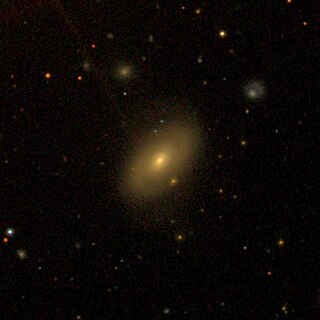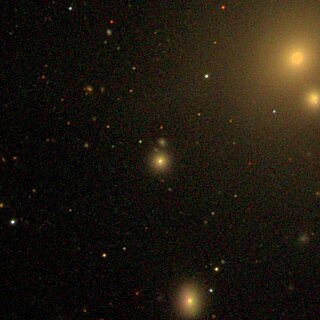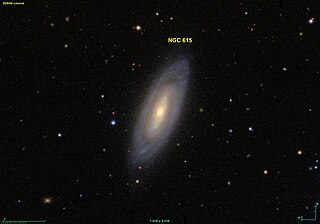
The Eskimo Nebula, also known as the Clown-faced Nebula, Lion Nebula, or Caldwell 39, is a bipolar double-shell planetary nebula (PN). It was discovered by astronomer William Herschel in 1787. The formation resembles a person's head surrounded by a parka hood. It is surrounded by gas that composed the outer layers of a Sun-like star. The visible inner filaments are ejected by a strong wind of particles from the central star. The outer disk contains unusual, light-year-long filaments.

NGC 6302 is a bipolar planetary nebula in the constellation Scorpius. The structure in the nebula is among the most complex ever observed in planetary nebulae. The spectrum of NGC 6302 shows that its central star is one of the hottest stars known, with a surface temperature in excess of 250,000 degrees Celsius, implying that the star from which it formed must have been very large.
NGC 5749 is an open cluster of stars positioned near the southwest border of the southern constellation of Lupus. It is located at a distance of 3,548 light years from the Sun. This is a poorly populated cluster that shows a low level of concentration; the Trumpler class is IV1p. There are 112 stars brighter than magnitude 14.4 within an angular radius of ~15′ of the cluster center, but only about 30% of these are members. NGC 5749 is 27 million years old with a tidal radius of 11.7 light years and a mass of ~21 M☉. Polarization measurements suggest there is a dust cloud within the cluster.
HD 221246 or NGC 7686 1 is a star in open cluster NGC 7686, and it belongs to the northern constellation of Andromeda. With an apparent visual magnitude of 6.17, it can be viewed by the naked eye only under very favourable conditions. It has a spectral classification of K3III, meaning it is an evolved orange giant star. Parallax measurements place this star about 1,000 light years away from the solar system.

WR 42e is a Wolf–Rayet star in the massive H II region NGC 3603 in the constellation of the Carina. It is around 25,000 light-years or 7,600 parsec from the Sun. WR 42e is one of the most massive and most luminous stars known.

NGC 342 is a lenticular galaxy in the constellation Cetus. It was discovered on September 27, 1864 by Albert Marth. It was described by Dreyer as "very faint, very small."

NGC 345 is a spiral galaxy located in the constellation Cetus. It was discovered on September 27, 1864 by Albert Marth. It was described by Dreyer as "very faint, very small, gradually brighter middle."

NGC 347 is a spiral galaxy in the constellation Cetus. It was discovered on September 27, 1864, by Albert Marth. It was described by Dreyer as "very faint, very small."

NGC 349 is a lenticular galaxy in the constellation Cetus. It was discovered on September 27, 1864 by Albert Marth. It was described by John Louis Emil Dreyer as "very faint, very small."

NGC 364 is a barred lenticular galaxy in the constellation Cetus. It was discovered on September 2, 1864 by Albert Marth. It was described by Dreyer as "very faint, very small."

NGC 373 is an elliptical galaxy located in the constellation Pisces. It was discovered on December 12, 1876 by John Louis Emil Dreyer. It was described by Dreyer as "very faint, very small."

NGC 387 is an elliptical galaxy located in the constellation Pisces. It was discovered on December 10, 1873 by Lawrence Parsons. It was described by Dreyer as "very faint, small, round." Along with galaxies NGC 375, NGC 379, NGC 382, NGC 383, NGC 384, NGC 385, NGC 386 and NGC 388, NGC 387 forms a galaxy cluster called Arp 331.

NGC 407 is an edge-on spiral or lenticular galaxy located in the constellation Pisces. It was discovered on September 12, 1784 by William Herschel. It was described by Dreyer as "very faint, very small, southwestern of 2.", the other being NGC 410.

NGC 429 is a lenticular galaxy of type S0^0: located in the constellation Cetus. It was discovered on December 20, 1786 by William Herschel. It was described by Dreyer as "very faint, very small."

NGC 445 is a peculiar lenticular galaxy located in the constellation of Cetus. It was discovered on October 23, 1864, by Albert Marth. It was described by Dreyer as "very faint, very small."

NGC 449 is a spiral galaxy of type (R')S? located in the constellation Pisces. It was discovered on November 11, 1881 by Édouard Stephan. It was described by Dreyer as "very faint, very small, round, very little brighter middle, very faint star involved."

NGC 7035 and NGC 7035A are a pair of interacting lenticular galaxies located around 400 to 430 million light-years away in the constellation of Capricornus. The main galaxy, NGC 7035 was discovered by astronomer Frank Muller in 1886.

NGC 6047 is an elliptical galaxy located about 430 million light-years away in the constellation Hercules. It was discovered by astronomer Lewis Swift on June 27, 1886. NGC 6047 is a member of the Hercules Cluster.

NGC 615 is an unbarred spiral galaxy seen edge-on located in the constellation Cetus. It is located at a distance of circa 70 million light years from Earth, which, given its apparent dimensions, means that NGC 615 is about 75,000 light years across. It was discovered by William Herschel on January 10, 1785. NGC 615 belongs to the NGC 584 galaxy group, which also includes the galaxies NGC 584, NGC 596, NGC 600, and NGC 636.

NGC 900 is a lenticular galaxy located in the constellation Aries about 430 million light-years from the Milky Way. It was discovered by the German astronomer Albert Marth in 1864.



















